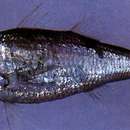Diagnostic Description
provided by Fishbase
Body moderately elongate, compressed. Scales large, weakly ciliated and deciduous. Two luminous organs run longitudinally in the abdominal muscle from the thorax to slightly beyond the anus and join each other at the anterior extremities.
Morphology
provided by Fishbase
Dorsal spines (total): 9; Dorsal soft rays (total): 10; Analspines: 3; Analsoft rays: 7
Trophic Strategy
provided by Fishbase
Found on the continental shelf, benthic (Ref. 75154). Inhabits sand and sandy mud bottoms (Ref. 11230).
- Recorder
- Grace Tolentino Pablico
Biology
provided by Fishbase
Inhabits sand and sandy mud bottoms (Ref. 11230). Marketed fresh or reduced to fishmeal.
Importance
provided by Fishbase
fisheries: commercial
分布
provided by The Fish Database of Taiwan
分布於印度-西太平洋區,西起東非,北至日本,南至阿拉夫拉海及澳洲北部。臺灣發現於北部、西部、南部、東北部、澎湖及小琉球海域。
利用
provided by The Fish Database of Taiwan
可利用底拖網捕獲。一般皆當下雜魚利用。
描述
provided by The Fish Database of Taiwan
體長橢圓形而側扁,腹面具U形發光器。頭大,頭後部稍突起。眼大。吻短。口大,斜裂,下頜稍突出,下頜縫合處不具棘狀突起;上頜末端及眼中部;上下頜前方均具犬齒,側邊、腭骨、鋤骨則具絨毛狀齒。前鰓蓋骨後緣平滑;鰓蓋骨無棘。體被弱櫛鱗,鱗大而較不易脫落;側線鱗數43-45。背鰭兩個,相距頗近,第一背鰭具硬棘VIII,第二背鰭鰭條I+10;臀鰭與背鰭軟條部相對,基底小於最長之鰭條長,具鰭條III+7;腹鰭略小,具鰭條I+5;胸鰭長而低位;尾鰭深叉形。肛門周圍黑色,位於腹鰭末端之前。體呈銀白色,背側黃褐色;各鰭淡色。
棲地
provided by The Fish Database of Taiwan
主要棲息於大陸棚斜坡,深度約在100-500公尺間。肉食性,以甲殼類為主食。
Acropoma japonicum
provided by wikipedia EN
Acropoma japonicum, the glowbelly, is a fish species in the family Acropomatidae found in the Indo-West Pacific. It is a benthopelagic predatory fish with a bioluminescent organ on its ventral surface. The glowbelly is an important food fish in some areas.
Description
Acropoma japonicum has a moderately elongated and compressed body with a covering of large scales which are deciduous. It has two light-producing organs, photophores in the abdominal muscle which run from the thorax to just past the anus, these are connected at the end nearest the fish's head. The dorsal fin of the glowbelly has 9 spines in its anterior portion with 10 soft rays behind them while the anal fin has 3 spines and 7 soft rays. This species attains a maximum total length of 20 centimetres (7.9 in).[1]
Distribution
Acropoma japonicum has a wide distribution in the Indo-Pacific region and it can be found from the eastern coast of Africa through the Indian Ocean and into the western Pacific Ocean as far north as Japan.[1]
Habitat and biology
Acropoma japonicum is a marine species with a depth range of 100–500 metres (330–1,640 ft)[2] It inhabits sand and sandy mud bottoms.[1] This is a predatory species in which the smaller individuals feed on copepods and caridean shrimp while the larger fish fed on those groups too but also preying on small fishes and krill.[3] This species is unusual in having what appears to be a short life cycle for a predatory fish, the juvenile fish begin to settle at the end of the breeding season and are sexually mature by the start of the following breeding season. As the breeding season progresses the body condition of the males worsens and as a result they have a higher mortality than the females. Most fish do not survive beyond their first breeding season and females dominate older age classes. The older age classes may also migrate to deeper waters.[4]
Human usage
Acropoma japonicum is an important food fish which is a bycatch in Korean waters but in Japan it is used in the commercial manufacture of fishcakes.[3] It is also used to make fishmeal.[1] This species is also of ecological importance as it is an important constituent of the diet of many commercially important fish species.[3]
Taxonomy
Acropoma japonicum was first formally described in 1859 by the German born British zoologist Albert Günther (1830-1914) with the type locality being given as the "Japanese Sea".[5] When Günther described it he placed it in a monotypic genus, Acropoma and so this species is the type species of that genus.[6] A number of new species have been described in the 2000s in the genus Acropoma, for example the glowblellies around Australia have been named as Acropoma leobergi.[7]
References
-
^ a b c d e Froese, Rainer; Pauly, Daniel (eds.) (2019). "Acropoma japonicum" in FishBase. December 2019 version.
-
^ "Fichas FAO de identificaçío de espécies para actividades de pesca. Guía de campo das espécies comerciais marinhas e de águas salobras de Moçambique". www.fao.org. Retrieved 2019-09-29.
-
^ a b c Joo Myun Park & Sung-hoi Huh (2018). "Ontogenetic and seasonal changes in the diets of the glowbelly Acropoma japonicum Gunther 1859 in the south-eastern waters of Korea". Indian Journal of Fisheries. 65 (1): 7–14. doi:10.21077/ijf.2018.65.167628-02.
-
^ Noboru Okuda; Hideki Hamoaka & Kojo Omori (2005). "Life history and ecology of the glowbelly Acropoma japonicum in the Uwa Sea, Japan". Fisheries Science. 71 (5): 1042–1048. doi:10.1111/j.1444-2906.2005.01062.x. Abstract
-
^ Eschmeyer, William N.; Fricke, Ron & van der Laan, Richard (eds.). "Acropoma japonicum". Catalog of Fishes. California Academy of Sciences. Retrieved 29 February 2020.
-
^ Eschmeyer, William N.; Fricke, Ron & van der Laan, Richard (eds.). "Acropoma". Catalog of Fishes. California Academy of Sciences. Retrieved 29 February 2020.
-
^ Bray, D.J. (2019). "Acropoma leobergi". Fishes of Australia. Museums Victoria. Retrieved 29 February 2020.

- license
- cc-by-sa-3.0
- copyright
- Wikipedia authors and editors
Acropoma japonicum: Brief Summary
provided by wikipedia EN
Acropoma japonicum, the glowbelly, is a fish species in the family Acropomatidae found in the Indo-West Pacific. It is a benthopelagic predatory fish with a bioluminescent organ on its ventral surface. The glowbelly is an important food fish in some areas.
- license
- cc-by-sa-3.0
- copyright
- Wikipedia authors and editors
Description
provided by World Register of Marine Species
Occurs in the continental shelf (Ref. 7300). Marketed fresh and reduced to fishmeal.
Froese, R. & D. Pauly (Editors). (2023). FishBase. World Wide Web electronic publication. version (02/2023).
- license
- cc-by-4.0
- copyright
- WoRMS Editorial Board

